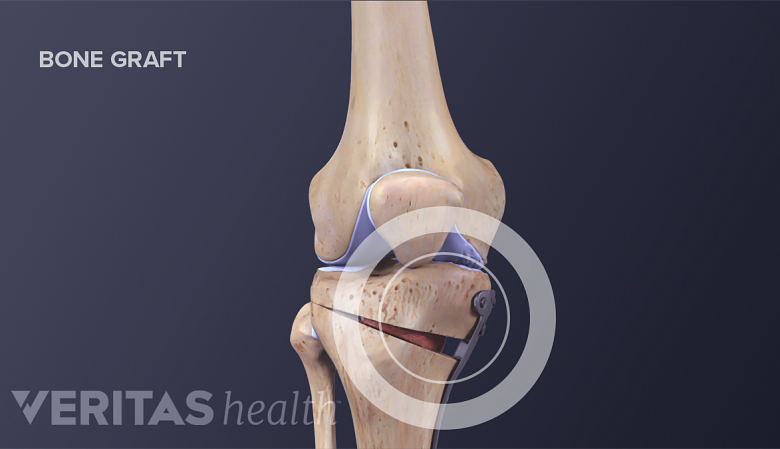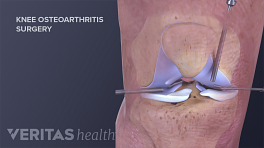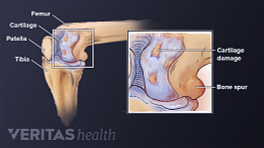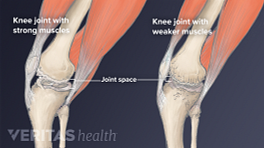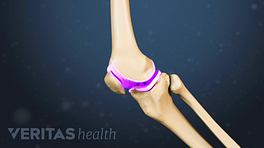“Knee osteotomy” is a bit of a misnomer, because the knee joint itself, where the surfaces of the tibia (shin bone), femur (thigh bone) and patella (knee cap) meet, is not surgically altered. Rather, the alignment of the femur and tibia is adjusted.
During knee osteotomy, a wedge of bone is removed and replaced by a bone graft secured by plates and screws.
In This Article:
Open or Closed Osteotomy
During surgery either the tibia or femur is cut from the side, and one of two types of osteotomy is performed.
Closed osteotomy
A wedge of bone is cut and removed. The resulting gap in the bone is closed by bringing the two sides together and securing them with a plate and screws.
Open osteotomy
A cut is made about three-quarters of the way across the bone. A wedge-shaped bone graft is inserted into the cut. The wedge is secured to the bone with a plate and screws. There are three types of bone graft–autograft, allograft, and artificial graft.
- Autograft. The inserted wedge is bone taken from another bone in the patient’s body, usually the pelvic bone, during the surgery.
- Allograft. The inserted wedge is bone from another person. Usually these grafts are procured from bone banks that harvest and freeze bone from cadavers.
- Artificial graft. The inserted wedge is made from a synthetic bone substitute.
Generally speaking, an autograft is the best option for post-surgical bone growth and healing, but some patients can have pain or other problems at the site where the bone was taken from the pelvis. What type of graft is used will be decided by the surgeon and patient.
A surgeon will make precise measurements regarding a patient’s leg alignment to determine whether to perform an osteotomy on the shin bone (tibia) or thigh bone (femur), decide which side of the bone to operate on, and calculate the exact size of the bone wedge to be added or removed for an osteotomy. How big of a wedge is added or removed depends on the person’s anatomy and degree of bow-legged or knock-kneed deformity. Typically, a 1 mm wedge will provide 1 degree of correction, so a 10 mm wedge will provide a 10-degree change in knee alignment. 1 Operative Techniques: Sports Knee Surgery, Mark D. Miller MD, Brian J. Cole MD MBA, Andrew Cosgarea, Jon K. Sekiya MD, July 7, 2008. Edition: 1 Har/DVD, Hardcover: 544 pages, Publisher: Saunders; 1 Har/DVD edition (July 7, 2008)
The most common type of knee osteotomy is a high tibial medial opening wedge osteotomy, a surgery that adds a wedge of bone graft or substitute to the inner shin bone, just below the knee. 2 The Knee Society. "Knee Osteotomy." Accessed December 29, 2011. http://www.kneesociety.org It is typically done for bowlegged patients, relieving pressure on the inside of the knee and transferring it to the outside of the knee.
Knee Osteotomy Surgery Procedure Step-by-Step
Below is a step-by-step description of a typical high tibial osteotomy surgery. Other types of osteotomies to correct knee osteoarthritis will follow the same general steps. A typical knee osteotomy surgery takes about 90 minutes to complete.
- The patient’s vital signs are checked to make sure blood pressure, heart rate, body temperature, and oxygenation levels are normal and surgery can proceed. A mark is made on the knee undergoing surgery.
- Anesthesia is administered. Patients receive general anesthesia (are put to sleep) or are given a regional anesthesia to block sensation from the waist down along with a relaxant. General anesthesia is more common. The type of anesthesia a patient receives is decided well ahead of time.
- Before the osteotomy is done, the surgeon may check the knee joint to confirm that there is no significant cartilage damage on the “good side” of the knee. This can be done arthroscopically right before the osteotomy procedure.
- If a meniscal repair, microfracture surgery to promote cartilage growth, or other arthroscopic surgery is to be performed in addition to the osteotomy, the arthroscopic surgery will be done first.
- The surgeon will make a 4 to 5 inch incision in the skin. For a high tibial osteotomy this incision will be below the knee. The surgeon must then make incisions in deeper soft tissue, such as muscle, to expose the bone to be altered.
- The surgeon uses a bone saw to make a precise cut from one side of the bone and stops short about 1 cm before reaching the other side. 3 Osteotomies Around the Knee: Indications, Planning, Surgical Techniques Using Plate Fixators. Edited by Philipp Lobenhoffer, Ronald van Heerwaarden, Alex Staubli, Roland Jakob, Publisher: Thieme; 1 edition (November 19, 2008)
- In a closed osteotomy, another cut is made and a wedge of bone is removed. In an open osteotomy a wedge-shaped bone graft is inserted into the cut bone. The surgeon will use a tool to gently tap the wedge into place.
- The surgeon will double-check the new knee alignment and, if necessary, adjust the size of the wedge.
- The bone at the osteotomy wound is pushed together (e.g. pressure may be exerted on the flat of the foot), and the newly altered bone is secured with metal plates and screws.
- The surgeon will close up the surgical wound.
- 1 Operative Techniques: Sports Knee Surgery, Mark D. Miller MD, Brian J. Cole MD MBA, Andrew Cosgarea, Jon K. Sekiya MD, July 7, 2008. Edition: 1 Har/DVD, Hardcover: 544 pages, Publisher: Saunders; 1 Har/DVD edition (July 7, 2008)
- 2 The Knee Society. "Knee Osteotomy." Accessed December 29, 2011. http://www.kneesociety.org
- 3 Osteotomies Around the Knee: Indications, Planning, Surgical Techniques Using Plate Fixators. Edited by Philipp Lobenhoffer, Ronald van Heerwaarden, Alex Staubli, Roland Jakob, Publisher: Thieme; 1 edition (November 19, 2008)
